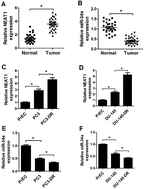Our official English website, www.x-mol.net, welcomes your feedback! (Note: you will need to create a separate account there.)
Long non-coding RNA NEAT1 contributes to docetaxel resistance of prostate cancer through inducing RET expression by sponging miR-34a
RSC Advances ( IF 3.9 ) Pub Date : 2017-09-05 00:00:00 , DOI: 10.1039/c7ra06107b Xin Tian 1, 2, 3, 4 , Guangwei Zhang 1, 2, 3, 4 , Hui Zhao 3, 4, 5 , Yang Li 1, 2, 3, 4 , Chaoyang Zhu 1, 2, 3, 4
RSC Advances ( IF 3.9 ) Pub Date : 2017-09-05 00:00:00 , DOI: 10.1039/c7ra06107b Xin Tian 1, 2, 3, 4 , Guangwei Zhang 1, 2, 3, 4 , Hui Zhao 3, 4, 5 , Yang Li 1, 2, 3, 4 , Chaoyang Zhu 1, 2, 3, 4
Affiliation

|
Background: Nuclear paraspeckle assembly transcript 1 (NEAT1) was demonstrated to serve as a carcinogenic long non-coding RNA (lncRNA) in multiple tumors including prostate cancer (PC). However, the potential biological role of NEAT1 in docetaxel resistance of PC and the underlying mechanism are largely unknown. Methods: Expressions of NEAT1 and miR-34a in PC tissues and cells were detected by qRT-PCR. The IC50 value of docetaxel and apoptosis in PC cells were examined by CCK-8 assay and flow cytometry analysis, respectively. Bioinformatics software and a luciferase reporter assay were used to predict and confirm the potential targets of miR-34a. A tumor xenograft assay was employed to verify the effect of NEAT1 on docetaxel resistance of PC cells in vivo. Results: NEAT1 was upregulated and miR-34a was downregulated in PC tissues, parental PC cells and docetaxel-resistant PC cells. NEAT1 knockdown improved sensitivity to docetaxel in docetaxel-resistant PC cells. In addition, NEAT1 functioned as a ceRNA of miR-34a in docetaxel-resistant PC cells to positively regulate the expression of RET (rearranged during transfection). Moreover, miR-34a inhibition partially reversed NETA1-knockdown-induced sensitivity to docetaxel in docetaxel-resistant PC cells. NEAT1 overexpression partially overturned RET-knockdown-mediated sensitivity to docetaxel in docetaxel-resistant PC cells. Furthermore, NEAT knockdown enhanced docetaxel sensitivity of docetaxel-resistant PC cells in vivo. Conclusion: NEAT1 contributed to docetaxel resistance of PC through inducing RET expression by sponging miR-34a, implying that targeting the NEAT1/miR-34a/RET axis may be a potential application in improving chemotherapy of PC.
中文翻译:

长非编码RNA NEAT1通过使miR-34a海绵化诱导RET表达,从而有助于前列腺癌的多西他赛耐药性
背景:核旁散装配体转录本1(NEAT1)被证明在包括前列腺癌(PC)在内的多种肿瘤中起着致癌的长非编码RNA(lncRNA)的作用。但是,NEAT1在PC对多西他赛耐药中的潜在生物学作用及其潜在机制尚不清楚。方法:采用qRT-PCR检测NEAT1和miR-34a在PC组织和细胞中的表达。通过CCK-8测定和流式细胞术分析分别检查多西紫杉醇的IC 50值和PC细胞的凋亡。使用生物信息学软件和荧光素酶报告基因测定法来预测和确认miR-34a的潜在靶标。肿瘤异种移植法用于验证NEAT1对体内PC细胞多西他赛耐药性的影响。结果:PC组织,亲代PC细胞和多西他赛耐药PC细胞中NEAT1上调,而miR-34a下调。NEAT1组合可提高耐多西他赛PC细胞对多西他赛的敏感性。此外,NEAT1在耐多西他赛的PC细胞中充当miR-34a的ceRNA,以正向调节RET的表达(在转染过程中重新排列)。此外,在抵抗多西他赛的PC细胞中,miR-34a的抑制作用部分逆转了NETA1敲低诱导的对多西他赛的敏感性。NEAT1的过表达部分推翻了抗多西他赛的PC细胞中RET敲低介导的对多西他赛的敏感性。此外,NEAT敲低增强了多西他赛耐药PC细胞在体内对多西他赛的敏感性。结论:NEAT1通过海绵化miR-34a诱导RET表达而促进PC对多西他赛的耐药性,这表明靶向NEAT1 / miR-34a / RET轴可能是改善PC化疗的潜在应用。
更新日期:2017-09-05
中文翻译:

长非编码RNA NEAT1通过使miR-34a海绵化诱导RET表达,从而有助于前列腺癌的多西他赛耐药性
背景:核旁散装配体转录本1(NEAT1)被证明在包括前列腺癌(PC)在内的多种肿瘤中起着致癌的长非编码RNA(lncRNA)的作用。但是,NEAT1在PC对多西他赛耐药中的潜在生物学作用及其潜在机制尚不清楚。方法:采用qRT-PCR检测NEAT1和miR-34a在PC组织和细胞中的表达。通过CCK-8测定和流式细胞术分析分别检查多西紫杉醇的IC 50值和PC细胞的凋亡。使用生物信息学软件和荧光素酶报告基因测定法来预测和确认miR-34a的潜在靶标。肿瘤异种移植法用于验证NEAT1对体内PC细胞多西他赛耐药性的影响。结果:PC组织,亲代PC细胞和多西他赛耐药PC细胞中NEAT1上调,而miR-34a下调。NEAT1组合可提高耐多西他赛PC细胞对多西他赛的敏感性。此外,NEAT1在耐多西他赛的PC细胞中充当miR-34a的ceRNA,以正向调节RET的表达(在转染过程中重新排列)。此外,在抵抗多西他赛的PC细胞中,miR-34a的抑制作用部分逆转了NETA1敲低诱导的对多西他赛的敏感性。NEAT1的过表达部分推翻了抗多西他赛的PC细胞中RET敲低介导的对多西他赛的敏感性。此外,NEAT敲低增强了多西他赛耐药PC细胞在体内对多西他赛的敏感性。结论:NEAT1通过海绵化miR-34a诱导RET表达而促进PC对多西他赛的耐药性,这表明靶向NEAT1 / miR-34a / RET轴可能是改善PC化疗的潜在应用。












































 京公网安备 11010802027423号
京公网安备 11010802027423号